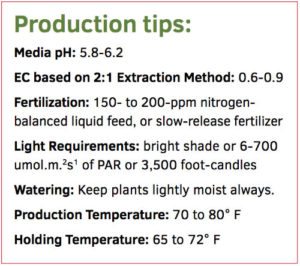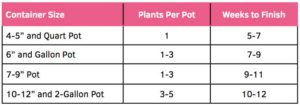
Culture Report: Hypoestes Hippo Series
The new Hippo hypoestes, or Pink Polka Dot Plant, from Proven Winners redefines this old-fashioned component plant with higher vigor, larger plant size and improved leaf color. ‘Hippo Red’ has large leaves, enameled with deep red tones over a dark green, almost black, leaf surface. ‘Hippo Rose’ also provides large leaves but with a rich rose-pink coloration and a lighter green underlay. Both have a mature height of 16 to 22 inches making them perfect for both small containers (4.5-inch or quart) and gallon container production. They make excellent monoculture containers or can be used as foliage accent/component plants in mixed containers.
 While most of the production information for the Hippo series is the same as the old fashioned hypoestes, the key is not to grow them with that generic crop in mind. Think more of how you would use coleus; the Hippo hypoestes are larger and better branched with dynamic color and enough vigor to do well in mixed containers with other moderate vigor companion plants. Like coleus they prefer a warmer greenhouse, and make an excellent shade tolerant foliage addition to your crop mix.
While most of the production information for the Hippo series is the same as the old fashioned hypoestes, the key is not to grow them with that generic crop in mind. Think more of how you would use coleus; the Hippo hypoestes are larger and better branched with dynamic color and enough vigor to do well in mixed containers with other moderate vigor companion plants. Like coleus they prefer a warmer greenhouse, and make an excellent shade tolerant foliage addition to your crop mix.
Temperature
The Hippo series likes a warm production environment and is best grown under production temperatures of 75 to 80° F day and 65 to 75° F night. Warm temperatures speed leaf and stem development and will give the fastest crop. As with any tropical crops, cooler production temperatures will slow the crop down, so plan accordingly. Avoid chilling (less than 50° F) and order so that your plants can be kept at optimal temperatures from the moment the shipment arrives. Use care to not overwater if production temperatures are lower than optimum. Since the Hippo series prefers warmer production temperatures, place orders to match when temperatures are correct for your area and avoid ordering plants in when greenhouses are cold.
Lighting
Hypoestes is a shade plant by nature, growing beneath the canopy of surrounding plants. Light levels need to be kept at 3,000 to 3,500 foot-candles. Higher light intensities (4,000 foot-candles or higher) can cause leaf curl, while lower light levels tend to make for an overall greener plant instead of the rich colors formed under brighter conditions. Avoid sharp changes in light level, such as moving plants from shade to bright intense sun; the plants will adapt to almost any light level but you want to avoid damaging existing leaves by too much stress.
Pinching and PGRs
No pinching is needed at all with this crop, and, given the correct light levels, branching is exceptionally good. Temperature makes a good growth regulator and dropping the temperature to 60 to 65° F can hold plants with minimal growth. If needed, sprays of a tank mix of 1,000-ppm B-Nine (daminozide) and 250- to 500-ppm Cycocel (chlormequat) can be effective but in general are likely not required. Chlormequat can also intensify foliage color. With all plant growth regulators, it is best to wait until you have some familiarity with how the crop will respond under your conditions and follow label instructions carefully. Ethephon can be used to reduce flowering, applied as a spray at 1,500 ppm. Use caution with this chemical as too much will cause plants to sprawl instead of their normal upright habit.
Foliage Interest
Hippo hypoestes is a quantitative (facultative) short day plant, and non-flowering foliage is your goal when growing the crop. The flowers are attractive but the main interest is the foliage, so keeping plants growing lushly and vegetatively
is the key to a fast, high-quality crop. Flowers will form eventually on mature plants, but flowering is enhanced with short days. Keep light levels at recommended levels and temperatures warm for faster crops. Keep fertilizer levels at 200 ppm as well to keep existing stalks growing rapidly and new leaves forming continuously.
The Hippo series is simple to produce and since it is primarily a foliage interest plant the retail shelf life is excellent. It can be grown with other bedding plants on a typical bedding plant program once temperatures are above 65° F in the greenhouse. The colorful foliage and larger stature make it an excellent shade annual for both containers and the landscape. Don’t forget it also makes an excellent house plant for the spring and fall markets when consumers are looking for indoor color.



 Video Library
Video Library 




















